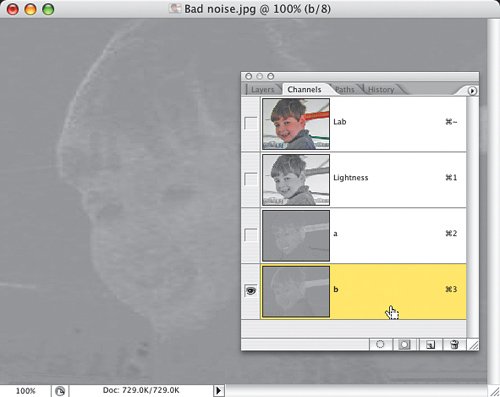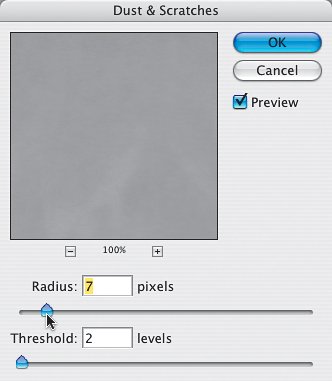| Q1: | I see you're using both Smart Sharpen and the Unsharp Mask filter. Which do you like better? |
| A1: | This is just a personal opinion thing, but I really like Smart Sharpen. I like the Lens Blur sharpening algorithm, I love the huge preview, and the fact that you can save your favorite settings. The default settings are a bit too strong for my taste, but outside of that, I really like it a lot. However, when I want something more subtle, I go back to Unsharp Mask. |
| Q2: | Does the "a" or "b" channel carry the most noise? |
| A2: | Generally it's the "b" channel (shown below), which holds the blue/yellow color components (it's easy to remember "b" for Blue channel noise). Even though "b" will usually hold the most noise, don't forget to check the "a" channel for noise, as well.  ©SCOTT KELBY |
| Q3: | Does noise just appear in the Blue channel? |
| A3: | Although it's usually most prevalent in the Blue channel (and it's usually the least visible in the Red channel), it can appear in all three channels, even though it's usually called Blue channel noise. |
| Q4: | I work with very high-res files that have really large file sizes, and the Unsharp Mask filter takes forever. Any workarounds? |
| A4: | That depends. If most of your sharpening will be visible in just one area, try this: put a selection around just that area, put that area on its own layer, then duplicate that layer into its own separate document (use the Duplicate Layer command from the Layers palette's flyout menu). Then apply the Unsharp Mask to just that small area (the filter will run much faster). Press-and-hold the Shift key and drag-and-drop that chunk back onto your original image, and it will snap back into its original location, but now it's sharpened. |
| Q5: | If applying a Gaussian Blur to the color channels doesn't work, what else can I try? |
| A5: | Undo the Gaussian Blur and instead try using the Dust and Scratches filter on the "b" channel and, if necessary, the "a" channel, as well.  |
| Q6: | What exactly does blurring the "a" and "b" channels do, because I can still see the noise? |
| A6: | Since we can't totally remove the noise, the idea is to reduce the color in the noise, which is what the human eye is most sensitive to. The blurring of the "a" and "b" channels greatly lessens the color in the noise, and that makes it less visible. |
| Q7: | What can I do to avoid noise in my digital photos? |
| A7: | Buy a better camera (hey, you asked). Generally, the better the digital camera, the less noise you get, but buying a new camera isn't always possible. One of the main things that you can control is not shooting with a high ISO setting. Although today's cameras are getting better and better at keeping noise at bay at high ISOs, the lower the ISO, generally the less noise you'll have to deal with later in Photoshop. |
| Q8: | If I apply the Unsharp Mask filter once, and it doesn't sharpen the photo enough, should I go back and pump up the settings, or just run the filter again? |
| A8: | Run the filter again. You'll generally get better results by applying the filter twice, rather than trying to double the settings. Also, if one application of the filter isn't enough, but applying it twice seems like too much, go under the Edit menu and choose Fade, and lower the Opacity (which just affects the second application of the filter). |